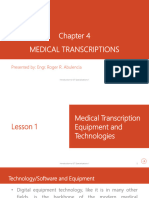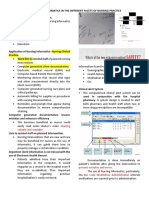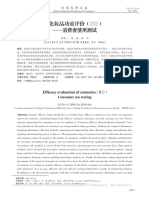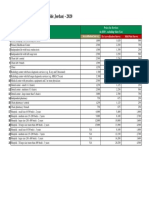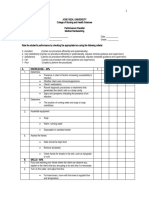0 ratings0% found this document useful (0 votes)
69 viewsHistory On Med Transcription
History On Med Transcription
Uploaded by
Little CrybabyThis document provides information on medical transcription. It discusses the history of medical record keeping from ancient Egyptians to modern technologies. It outlines the core competencies, skills, and qualifications needed for medical transcriptionists including touch typing, use of medical terminology, listening skills, and producing accurate transcripts. It also discusses legal and ethical considerations like HIPAA compliance and maintaining patient privacy.
Copyright:
© All Rights Reserved
Available Formats
Download as DOCX, PDF, TXT or read online from Scribd
History On Med Transcription
History On Med Transcription
Uploaded by
Little Crybaby0 ratings0% found this document useful (0 votes)
69 views4 pagesThis document provides information on medical transcription. It discusses the history of medical record keeping from ancient Egyptians to modern technologies. It outlines the core competencies, skills, and qualifications needed for medical transcriptionists including touch typing, use of medical terminology, listening skills, and producing accurate transcripts. It also discusses legal and ethical considerations like HIPAA compliance and maintaining patient privacy.
Original Title
HISTORY ON MED TRANSCRIPTION
Copyright
© © All Rights Reserved
Available Formats
DOCX, PDF, TXT or read online from Scribd
Share this document
Did you find this document useful?
Is this content inappropriate?
This document provides information on medical transcription. It discusses the history of medical record keeping from ancient Egyptians to modern technologies. It outlines the core competencies, skills, and qualifications needed for medical transcriptionists including touch typing, use of medical terminology, listening skills, and producing accurate transcripts. It also discusses legal and ethical considerations like HIPAA compliance and maintaining patient privacy.
Copyright:
© All Rights Reserved
Available Formats
Download as DOCX, PDF, TXT or read online from Scribd
Download as docx, pdf, or txt
0 ratings0% found this document useful (0 votes)
69 views4 pagesHistory On Med Transcription
History On Med Transcription
Uploaded by
Little CrybabyThis document provides information on medical transcription. It discusses the history of medical record keeping from ancient Egyptians to modern technologies. It outlines the core competencies, skills, and qualifications needed for medical transcriptionists including touch typing, use of medical terminology, listening skills, and producing accurate transcripts. It also discusses legal and ethical considerations like HIPAA compliance and maintaining patient privacy.
Copyright:
© All Rights Reserved
Available Formats
Download as DOCX, PDF, TXT or read online from Scribd
Download as docx, pdf, or txt
You are on page 1of 4
MEDICAL TRANSCRIPTION
HISTORY ON MED TRANSCRIPTION - Units of Competency
Basic Competencies
- Oldest medical records – ancient Egyptians would Common Competencies
write their observations on papyrus. Core Competencies
HANDLING MEDICAL RECORD KEEPING BASIC COMPETENCIES
- Participate in workplace communication
- Handwriting - Work in a team environment
Time-consuming - Practice career professionalism
- Sound Recording or Taping - Practice occupational health and safety procedures
Increasing popularity with doctors
- The Doctor typing in their own reports COMMON COMPETENCIES
- Speech to Text Applications - Apply quality standards
Can be very inaccurate - Perform computer operation
IMPORTANCE TO KEEP MEDICAL RECORDS CORE COMPETENCIES
- Use business technology
- May influence the difference whether the patient will - Use medical terminology to carry out task
live or die - Produce text from audio transcription
- Keep permanently
SKILLS OF A MED TRANSCRIPTION
MEDICAL TRANSCRIPTION - Touch typing skills
- MT English and Medical Terminology Proficiency
- Translating from oral to written form in order to - Listening and Audio Transcription
document patient care and facilitate healthcare - Accuracy – 98-100%
services the record of a person’s - Speed – not <45 words per min
Medical history
Diagnosis TOUCH TYPING REQUIREMENTS
Prognosis
Outcome - In accordance with the required output
- Accuracy of information is checked and information
GENERAL WORKFLOW is saved in accordance with standard operating
procedure
- (1) Hospitals/Doctors - Appropriate technology and software applications
Dictate Transfer are selected to achieve the requirements of the
- (2) Med Transcriptions Operations tasks
Receive Transcribe Deliver
- (3) Hospitals/Doctors MT ENGLISH AND MEDICAL TERMINOLOGY
Receive PROFICIENCY REQUIREMENTS
MEDICAL TRANSCRIPTIONIST EARNINGS - Written and oral instructions using medical
terminology are received, understood, and properly
- 35,000/12months = 2916$ documented
- 2916/3- days = 97$ - Abbreviations for commonly used medical terms and
- 97 x 50.82php = 4929.54 pesos per day associated processes are understood
- Medical terminologies are used correctly I the
MED TRANSCRIPTION NC II QUALIFICATIONS completion of routine tasks
- Medical terminology is spelt correctly and used in
- TESDA Description appropriate context
Consists of competencies that a person must - Grammar and syntax are appropriate for the
achieve to transcribe dictated recordings intended purpose
made by physician and other health care
professionals and transcribe them into LISTENING AND AUDIO TRANSCRIPTION
medical reports
MEDICAL TRANSCRIPTION
- Appropriate hardware and software are selected
- Accuracy of information is checked and information
is saved in accordance with standard operating
procedures
- Appropriate technology and software applications
AUDIO TRANSCRIPTION PERFORMANCE CRITERIA
- Text is produced from transcription with the required
accuracy
- Audio transcription reflected the intended meaning of
the author or physician
- Meaning, spelling, and technical terms are clarified
to ensure accuracy of the text
- Text is produced within designated
LEGALITIES AND ETHICS IN MED TRANSCRIPTION
- HEALTH INSURANCE PORTABILITY AND
ACCOUNTABILITY ACT (HIPAA)
Created primarily to modernize flow of
healthcare information
Stipulate how Personally Identifiable
Information maintained by the healthcare and
healthcare insurance industries should be
protected from fraud and theft
To address limitations on healthcare
insurance coverage – such as portability and
the coverage of individuals with pre-existing
conditions
-
MEDICAL TRANSCRIPTION
BAD HABITS CHECKLIST
TOUCH TYPING Bad Habit Correction
Slouching Sit up straight with your
- A method of typing without the use of the sense of feet and well supported
sight or simply feeling the keyboard Reaching too far for the Sit one hand’s length
- Governed by muscle memory through rigorous keyboard or the mouse from the keyboard. Keep
training with the proper typing method Leaning your hand on the Hover your hands over
- Leads to increased typing speed keyboard or the wrist the keyboard: curl your
support fingers slightly
BASICS OF TOUCH TYPING Bending your wrist Keep your forearms and
forward back, left, or right wrists straight and in the
- Positioning neutral position
- Stretching and Resting Pounding the keys Strike keys slightly
- Familiarizing which finger to user per key Looking at the keyboard Position the work stand
- *** Read pages 2-7 of Keyboarding Essentials close to the monitor at
eye level. Keep your eyes
POSTURE on your work
Raising your elbows Keep your arms close to
- Do not slouch your body
- Keep the keyboard flat Raising your shoulders Keep your shoulders
- Center yourself on the J key relaxed with your chest
- The fingers should be positioned on the “home open and wide
key/row” Keying with the wrong Practice with correct
- Home Keys; fingers fingers until you establish
Left Hand: ASDF the right habit. Your
Index: F speed will then improve
Middle: D
Ring: S
LITERACY SKILLS
Pinky: A
Right Hand: JKL;
- Reading
Index: J
- Writing
Middle: K
- Thinking
Ring: L
- Speaking
Pinky: ;
- Listening
- Thumb Finger = Space Bar
- Keyboarding
CORRECT SITTING POSTURE FOR COMPUTER
CORRECT FINGER MOVEMENTS
- Eyes level with top of monitor
- Press the key with a quick and snappy stroke
- Chin down
- Return to home key after every stroke
- Shoulders down elbows close to the body
- Arms parallel to floor resting on arm support
- Back support for curve in spine
- Feet flat on floor
STRETCHING AND RESTING
- To relieve the tension and reduce the threat of injury,
you should stretch before you start keying.
- You should also take short breaks from keying every
20-30 minutes and stretch.
- Stretch 1: Neck Stretch
- Stretch 4: Downward Wrist …
MEDICAL TRANSCRIPTION
You might also like
- Free Medical Transcription Course PDFDocument28 pagesFree Medical Transcription Course PDFMichellePascualPullon91% (11)
- Risk Management Plan: Fatima Hill Pharmacy APRIL 2019Document11 pagesRisk Management Plan: Fatima Hill Pharmacy APRIL 2019Sushmita Mae Cajes91% (11)
- CDC Modernapfizer EmailsDocument1,433 pagesCDC Modernapfizer EmailsZerohedge JanitorNo ratings yet
- 3-Electronic Health RecordDocument11 pages3-Electronic Health RecordConger Conger100% (1)
- Transcribing Doctors OrderDocument6 pagesTranscribing Doctors OrderMarielle Chua100% (1)
- NCM 110 Midterm ReviewerDocument3 pagesNCM 110 Midterm ReviewerBrandone Dave ParagosoNo ratings yet
- Introduction To Medical TranscriptionDocument16 pagesIntroduction To Medical Transcriptiongenelie songcayawon100% (2)
- Introduction To MTDocument40 pagesIntroduction To MTAnne2_30100% (2)
- MEDI Reviewer DASAL MALALADocument5 pagesMEDI Reviewer DASAL MALALAgieraldguerrero55No ratings yet
- Chapter 15 To 18Document13 pagesChapter 15 To 18Alexandra AyneNo ratings yet
- Basic Concepts of Nursing Notes by Lei Talabis 1Document8 pagesBasic Concepts of Nursing Notes by Lei Talabis 1Love Jovellanos ÜNo ratings yet
- FUNDADocument6 pagesFUNDAkhayceemeade2No ratings yet
- -3 Job-AnalysisDocument7 pages-3 Job-Analysishhkkiittyy16No ratings yet
- Medical Transcriptionist: DutiesDocument4 pagesMedical Transcriptionist: DutiesJanine Binbing100% (1)
- 2.medical TranscriptionDocument61 pages2.medical TranscriptionAmeerah CabangalNo ratings yet
- 320 Surg 0547 - JDDocument9 pages320 Surg 0547 - JDKiruba Jones Antony RajNo ratings yet
- HMPPT5Document24 pagesHMPPT5Prasidha PrabhuNo ratings yet
- Info LecDocument4 pagesInfo Lecjshaymin8No ratings yet
- Body Temp: Graphic ChartDocument7 pagesBody Temp: Graphic ChartShyenNo ratings yet
- Body Temp: Graphic ChartDocument7 pagesBody Temp: Graphic ChartShyenNo ratings yet
- Chapter 4 Lesson 1 Medical Terminology Technologies - Software - 095834Document14 pagesChapter 4 Lesson 1 Medical Terminology Technologies - Software - 095834Leizel AbugNo ratings yet
- Funda SemisDocument7 pagesFunda SemisclaribelNo ratings yet
- The Medical TranscriptionistDocument22 pagesThe Medical TranscriptionistrimeoznekNo ratings yet
- MEDICAL TRANSCRIPTION - IntroductionDocument9 pagesMEDICAL TRANSCRIPTION - IntroductionRDSNo ratings yet
- 110 LEC Overview of Informatics in Health Care Printable NotesDocument6 pages110 LEC Overview of Informatics in Health Care Printable NotesTrishaNo ratings yet
- Group 3_ramos Scrapbook DigitalDocument16 pagesGroup 3_ramos Scrapbook Digitaledmund24200707No ratings yet
- NI - Application of Nursing InformaticsDocument4 pagesNI - Application of Nursing InformaticsRose Anne AbivaNo ratings yet
- Med TransDocument8 pagesMed TransAnya MayNo ratings yet
- JD - Radiographer MRI-CT - Sulis Feb 2024Document4 pagesJD - Radiographer MRI-CT - Sulis Feb 2024mrxmdxsc7nNo ratings yet
- Finals Notes NiDocument11 pagesFinals Notes NiSteph CaronanNo ratings yet
- New Mowasat HospitalDocument3 pagesNew Mowasat HospitalPaul PhiliphsNo ratings yet
- Becoming A Student Nurse: IndividualDocument21 pagesBecoming A Student Nurse: IndividualShyenNo ratings yet
- MEDICAL-TRANSCRIPTIONDocument8 pagesMEDICAL-TRANSCRIPTIONromarccharNo ratings yet
- REVIEWERDocument7 pagesREVIEWERKnox VienuexNo ratings yet
- JD Medical Secretary Oct 2019Document10 pagesJD Medical Secretary Oct 2019M LubisNo ratings yet
- 6450 Nasometer II K10M1108Document4 pages6450 Nasometer II K10M1108Dan GarcesNo ratings yet
- Consumer Health EducationDocument5 pagesConsumer Health Educationkc remularNo ratings yet
- Medical ProceduresDocument33 pagesMedical ProceduresAlistair ElliseNo ratings yet
- Dispensing ReviewerDocument3 pagesDispensing ReviewerYap Jacky100% (1)
- Medical Transcription (Medical Records)Document32 pagesMedical Transcription (Medical Records)Rana Abd Almugeeth100% (5)
- Chapter 9Document4 pagesChapter 9BORDALLO, ANGELEIGHNo ratings yet
- M0051-Heng SeangMengDocument4 pagesM0051-Heng SeangMengColguidesNo ratings yet
- Professional Standards To Meet The TOC21 For Adult NursingDocument8 pagesProfessional Standards To Meet The TOC21 For Adult Nursingmbibaellen8No ratings yet
- Highland 189898 Job DescriptionDocument8 pagesHighland 189898 Job Descriptionolugbodisola2016No ratings yet
- Medical Transcription - WikipediaDocument8 pagesMedical Transcription - WikipediaAvinash NagNo ratings yet
- Bing B5Document8 pagesBing B5Novia ZNo ratings yet
- ROJoson PEP Talk: GENERICS LAW and MEDICINESDocument43 pagesROJoson PEP Talk: GENERICS LAW and MEDICINESrojosonNo ratings yet
- Health AssessmentDocument11 pagesHealth AssessmentJohana AngkadNo ratings yet
- 2.00 - Subjective Data Collection (Highlighted)Document3 pages2.00 - Subjective Data Collection (Highlighted)ALYSSA NICOLE FLORESNo ratings yet
- Informatics Application in EvidenceDocument4 pagesInformatics Application in EvidenceSyrille FedericoNo ratings yet
- Transcribing Doctors OrderDocument6 pagesTranscribing Doctors OrderLiza SoberanoNo ratings yet
- Abt Medical TranscriptionDocument10 pagesAbt Medical TranscriptionprasoonNo ratings yet
- SAG - Medical Transcription NC IIDocument2 pagesSAG - Medical Transcription NC IIQueng C MCNo ratings yet
- 2 Teleconsultation For Filipino CliniciansDocument25 pages2 Teleconsultation For Filipino CliniciansTwinkle Salonga0% (1)
- Strategies For The Successful Implementation of Digital HealthDocument45 pagesStrategies For The Successful Implementation of Digital HealthRashmi SainiNo ratings yet
- Medico Legal and Patient Safety Through Information DisseminationDocument14 pagesMedico Legal and Patient Safety Through Information Disseminationplus91No ratings yet
- Resume of RiversdjDocument2 pagesResume of Riversdjapi-24300194No ratings yet
- Aval Disartria Preencial e OnlineDocument3 pagesAval Disartria Preencial e OnlineFernanda BastosNo ratings yet
- Nuance Dragon Medical Practise Edition 3 DatasheetDocument4 pagesNuance Dragon Medical Practise Edition 3 DatasheetWebAntics.com Online Shopping StoreNo ratings yet
- Job Description & Person SpecificationDocument8 pagesJob Description & Person SpecificationHarshavardhan SNo ratings yet
- A DXA Primer for the Practicing Clinician: A Case-Based Manual for Understanding and Interpreting Bone DensitometryFrom EverandA DXA Primer for the Practicing Clinician: A Case-Based Manual for Understanding and Interpreting Bone DensitometryNo ratings yet
- District Ayurved and Health CenterDocument2 pagesDistrict Ayurved and Health CenterSwikriti BPharmNo ratings yet
- 化妆品功效评价 消费者使用测试 刘唯一Document6 pages化妆品功效评价 消费者使用测试 刘唯一adam fuNo ratings yet
- Philippine College of Chest PhysiciansDocument10 pagesPhilippine College of Chest PhysiciansElveanne SilvaNo ratings yet
- Mapping of Coronary Stent Demand of Several Hospitals in Indonesia and Its ForecastingDocument5 pagesMapping of Coronary Stent Demand of Several Hospitals in Indonesia and Its ForecastingMakhyan JibrilNo ratings yet
- M M M MM M M !M" M" M #$%! M"! M M# M M M "&"M M "&"M M "&"M #$%! "&"M "&"M !M" M" "&"M "&"MDocument5 pagesM M M MM M M !M" M" M #$%! M"! M M# M M M "&"M M "&"M M "&"M #$%! "&"M "&"M !M" M" "&"M "&"Mbkpanda20065753No ratings yet
- Loan License 24E Application FormDocument6 pagesLoan License 24E Application FormprapannraghavNo ratings yet
- Jurnal 16 inDocument11 pagesJurnal 16 inAn anonymousNo ratings yet
- Injections and Infusions Coding HandbookDocument26 pagesInjections and Infusions Coding HandbookЩербакова ЛенаNo ratings yet
- KH Brochure 2024Document6 pagesKH Brochure 2024vdvedNo ratings yet
- Patients HistoryDocument2 pagesPatients HistoryJohn Angelo ValdezNo ratings yet
- National Health Policy and PlanDocument92 pagesNational Health Policy and PlanChetan BhattaNo ratings yet
- Models of HealthcareDocument3 pagesModels of HealthcarenehemiahwasikeNo ratings yet
- Surgitoons GIT Surgitoons - Bak PDFDocument127 pagesSurgitoons GIT Surgitoons - Bak PDFAlejandra Rozo BayerNo ratings yet
- LST Published Price List 21jan2020 en PDFDocument1 pageLST Published Price List 21jan2020 en PDFIyad ShahatitNo ratings yet
- Hinkle 15TH Edition Test Bank CHDocument60 pagesHinkle 15TH Edition Test Bank CHgichaucarenNo ratings yet
- Pharmacopoeia of Siddha MedicineDocument151 pagesPharmacopoeia of Siddha MedicineBalaji RamakrishnanNo ratings yet
- How To Use The Aspen Cervical CollarDocument4 pagesHow To Use The Aspen Cervical CollardesytrilistyoatiNo ratings yet
- Pediatric Tracheostomy Home Care GuideDocument37 pagesPediatric Tracheostomy Home Care GuideMarko MedićNo ratings yet
- Revisi Jadwal Ruang Anyelir 21 Juni - 20 Juli 2021Document9 pagesRevisi Jadwal Ruang Anyelir 21 Juni - 20 Juli 2021Ery LeksanaNo ratings yet
- Im InjectionDocument4 pagesIm InjectionKaur KaurNo ratings yet
- Leave Request Form (1-12)Document5 pagesLeave Request Form (1-12)Gretta FernandesNo ratings yet
- BSC Nursing SyllabusDocument10 pagesBSC Nursing SyllabusTanaka MukuwiriNo ratings yet
- Uji Efek Antipiretik Ekstrak Etanol Daun Bayam MERAH (Amaranthus Tricolor L.) PADA TIKUS PUTIH (Rattus Norvegicus) JANTAN GALUR WISTARDocument9 pagesUji Efek Antipiretik Ekstrak Etanol Daun Bayam MERAH (Amaranthus Tricolor L.) PADA TIKUS PUTIH (Rattus Norvegicus) JANTAN GALUR WISTARWIDIA PUSPITA FAJRINo ratings yet
- Dialog English Nurs and Patient NewDocument6 pagesDialog English Nurs and Patient NewRisma Faudiyah100% (2)
- Medical HandwashingDocument3 pagesMedical HandwashingEj Mae FabiNo ratings yet
- Gallbladder Stone & Homoeopathy - Gallstone and HomoeopathyDocument2 pagesGallbladder Stone & Homoeopathy - Gallstone and HomoeopathyAnonymous kielG2100% (1)
- D 0131-HipotermiaDocument2 pagesD 0131-HipotermiaKamelNo ratings yet
- Medcure Business Solution - Investor DeckDocument15 pagesMedcure Business Solution - Investor DeckManoj Kumar AcharyNo ratings yet
- Women's Perception Towards Ayurvedic Cosmetics.Document58 pagesWomen's Perception Towards Ayurvedic Cosmetics.abdulghani1529No ratings yet




















